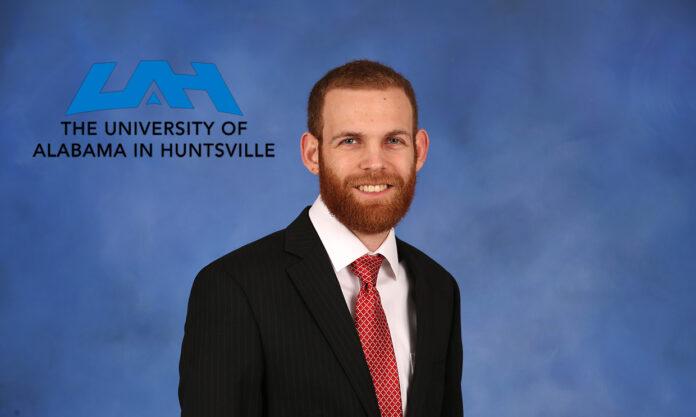HUNTSVILLE — Research to propel microsatellites and CubeSats will take a University of Alabama in Huntsville student to Sandia National Laboratories in New Mexico this fall.
Andrew Walsten, a native of Mulvane, Kan., is a doctoral student in aerospace engineering. He will intern under the Department of Energy Office of Science Graduate Student Research program. He is one of 80 graduate students representing 17 states who will travel to Sandia in October.
“I have never won anything like this before so I was really excited,” he said. Walsten’s advisor is Dr. Gabe Xu, an associate professor of mechanical and aerospace engineering.
“I ended up at UAH because, when I graduated from Kansas State University, I was interested in working on electric propulsion for grad school,” Walsten said. “I applied to a bunch of schools that were doing electric propulsion research and got an offer from Dr. Xu that I accepted.”
The SCGSR program provides opportunities for graduate students to conduct part of their graduate thesis research at a DOE laboratory or facility, in collaboration with a DOE laboratory scientist. SCGSR research projects are expected to advance the graduate awardee’s overall doctoral thesis while providing access to the expertise, resources and capabilities available at the DOE laboratories or facilities.
The program provides supplemental awards for graduate students to spend three to 12 consecutive months at a DOE national laboratory or facility conducting graduate thesis research with a DOE laboratory scientist. The award provides support for inbound and outbound travel to the laboratory, and a monthly stipend of up to $3,000 for general living expenses.
“There are a lot of different types of electric propulsion, but I am specifically looking at a Hall thruster design,” Walsten said. “Hall thrusters are a mature technology that have been flown in space before. They are an annular device and you can find a bunch of images for them online.”
The engine’s propellant is fed through the base of the annular chamber where the anode is also located. Electrons are emitted from an external cathode. A potential difference develops between the cathode and anode which results in an electric field and accelerates the electrons toward the anode. But the electrons encounter a radial magnetic field at the channel entrance and start spiraling around the annulus in what is known as a Hall current.
“These electrons that are spiraling around the chamber then collide with the neutral propellant gas and ionize it,” Walsten said. “The resulting ions are then accelerated out of the thruster by the electric field that developed between the cathode and anode.”
The ejected ion plasma provides the thrust. Some of the emitted electrons are used to neutralize the beam so that no charge builds up on the spacecraft.
“These thrusters provide thrusts anywhere from a few micronewtons to a few newtons, with specific impulses in the thousands of seconds depending on what size Hall thruster you are using,” Walsten said. “The thrusts are very low when compared to chemical rockets, but the high specific impulse is a big benefit.”
That’s because specific impulse in propulsion is analogous to gas mileage in cars, and a high specific impulse is more fuel efficient.
At Sandia, Walsten will be mentored by physicist Dr. Brian Bentz, and the pair will use laser-collisional induced fluorescence to map the engine’s plasma distribution and compare it to the magnetic fields to better understand the plasma’s behavior and how it affects the performance of the thruster.
At UAH, Xu said Walsten has been doing experimental work on low-temperature plasmas since 2018 and has published two journal papers and three conference papers.
“He first started working on an Army project on diode pumped rare gas lasers,” Dr. Xu said. “He learned the research very quickly and gave his first conference presentation that very first year, a very rare event.”
The move to Sandia will open new research horizons for him, Walsten said, but he points out that it won’t all be work.
“It’s not research-related,” he said. “But I’m looking forward to doing a lot of hiking while down in Albuquerque.”
Don’t miss out! Subscribe to our email newsletter to have all our smart stories delivered to your inbox.



